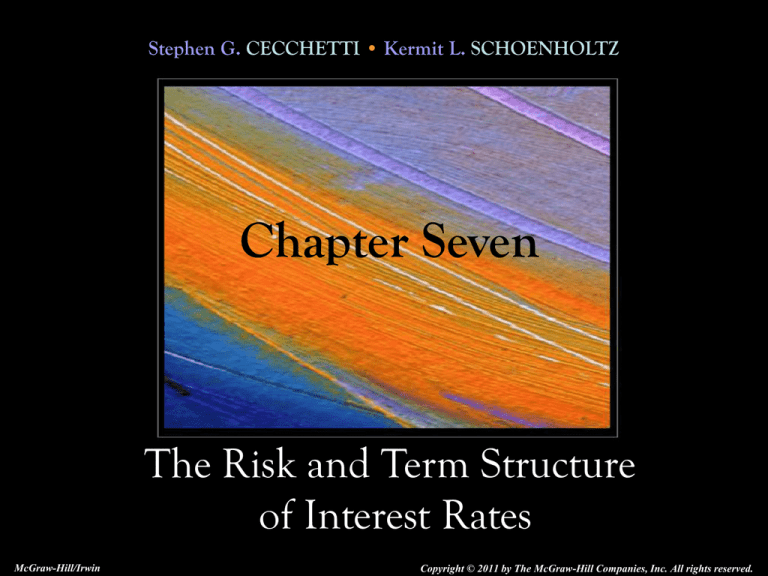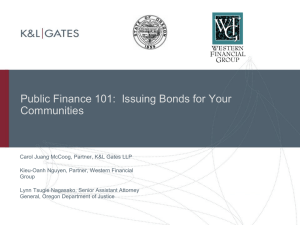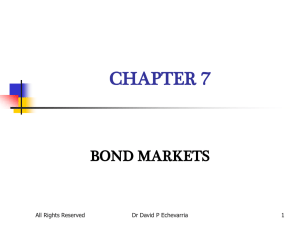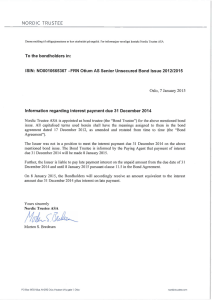
Stephen G. CECCHETTI • Kermit L. SCHOENHOLTZ
Chapter Seven
The Risk and Term Structure
of Interest Rates
McGraw-Hill/Irwin
Copyright © 2011 by The McGraw-Hill Companies, Inc. All rights reserved.
Introduction
• Changes in bond prices and the associated
changes in interest rates, can have a pronounced
effect on borrowing costs corporations face.
• In 1998 we saw the simultaneous increase in some
interest rates and decline in others - a rise in what are
called interest rate spreads.
• Changes in the perceived risk of Ford’s and GM’s
bonds led to declines in prices.
• This leads to increases in interest rates and higher
corporate borrowing costs.
7-2
Introduction
•
We must be able to distinguish among many
different types of bonds that are traded in
financial markets.
The purpose of this chapter is:
1. To examine how the issuer and time to
maturity affect the price of a bond, and
2. To use our knowledge to interpret fluctuations
in a broad variety of bond prices.
7-3
Ratings and the Risk Structure of
Interest Rates
• Default is one of the most important risks a
bondholder faces.
• In fact, independent companies (rating
agencies) have arisen to evaluate the
creditworthiness of potential borrowers.
• These companies estimate the likelihood that the
corporate or government borrower will make a
bond’s promised payments.
• The government has acknowledged a few firms as
“nationally recognized statistical rating
organizations” (NRSROs).
7-4
Bond Ratings
• The best known bond rating services are
• Moody’s
• Standard & Poor’s
• They monitor the status of individual bond
issuers and assess the likelihood a lender will
be repaid by the bond issuer.
• A high rating suggests that a bond issuer will
have little problem meeting a bond’s payment
obligations.
7-5
Bond Ratings
• Firms or governments with an exceptionally
strong financial position carry the highest
ratings and are able to issue the highest-rated
bonds, Triple A.
• Ex: U.S. Government, ExxonMobil, Microsoft
• The top four categories are considered
investment-grade bonds.
• These bonds have a very low risk of default.
• Reserved for most government issuers and
corporations that are among the most financially
sound.
7-6
Bond Ratings
• The distinction between investment-grade and
speculative, noninvestment-grade is important.
• A number of regulated institutional investors are not
allowed to invest in bonds rated below Baa on
Moody’s scale or BBB on Standard and Poor’s
scale.
7-7
7-8
Bond Ratings
• Speculative grade bonds are bonds issued by
companies and countries that may have
difficulty meeting their bond payments but are
not at risk of immediate default.
• Highly speculative bonds include debts that are
in serious risk of default.
• Both speculative grades are often referred to as
junk bonds or high-yield bonds.
7-9
Bond Ratings
• Types of junk bonds:
• Fallen angels are bonds that were once investmentgrade, but their issuers fell on hard times.
• Bonds issued by issuers about which there is little
known.
• Material changes in a firm’s or government’s
financial conditions precipitate changes in its
debt ratings.
• Ratings downgrade - lower an issuer’s bond rating.
• Ratings upgrade - upgrade an issuer’s bond rating.
7-10
• What is a subprime mortgage?
• A residential mortgage is called subprime when it
does not meet the key standards of creditworthiness
that apply to conventional prime mortgages.
• Conventional mortgages are those that satisfy the
riles for inclusion in a collection or pool of
mortgages to be guaranteed by a U.S. Government
agency.
• The standards cover the size of mortgage, price of
the home, and the ratio between the two: the loanto-value ratio (LTV ratio).
7-11
• Subprime loans may fail to meet some or all of
these standards for a qualifying mortgage.
• Like other loans, subprime loans can be at a
fixed or variable rate (ARMs).
• ARMs typically provide a low interest rate, or
teaser rate, for a couple of years and then the
interest resets to a higher rate.
• This gives borrowers the ability to refinance after
the introductory rate is up.
7-12
• Although at their peak subprime mortgages
accounted for less than 15 percent of overall
residential mortgages, they helped trigger the
financial disruptions of 2007-2009.
• The key reason is that some large, highly
leveraged financial institutions held a sizable
volume of MBS backed by subprime
mortgages.
• These financial institutions had “bet the house”
on subprime mortgage securities.
7-13
• As the government sought to reform the
financial system after the financial crisis of
2007-2009, the role of ratings agencies
attracted great attention.
• Investors around the world had relied on the
high ratings agencies had awarded to a large
groups of mortgage-backed securities (MBS).
• As housing prices began to fall, agencies made
sharp downgrades.
• Downgrades lowered MBS prices.
7-14
• What caused the ratings errors?
• Data didn’t have sufficient information.
• Firms hire the agencies to consult on what types of
MBS have the highest ratings and then rate them,
which was a conflict of interest.
• Ratings agencies are compensated by the issuers of
the bonds.
• Agencies used a single rating scale to represent
default probabilities, independent of other
characteristics like liquidity.
• This may have led investors to underestimate
other important risks.
7-15
Commercial Paper
• Commercial paper is a short-term version of a
bond.
• The borrower offers no collateral so the debt is
unsecured.
• Commercial paper is
• Issued on a discount basis, as a zero-coupon
bond specifying a single future payment with no
associated coupon payments.
• Has maturity of less than 270 days.
• More than one third is held by money-market
mutual funds.
7-16
Commercial Paper
• Most commercial paper is issued with a
maturity of 5 to 45 days and is used exclusively
for short-term financing.
• The rating agencies rate the creditworthiness of
commercial paper issuers in the same way they
do bond issuers.
• Almost all carry Moody’s P-1 or P-2 rating
• P stands for prime grade commercial paper.
• Speculative-grade commercial paper does exist, but
not because it was issued as such.
7-17
Commercial Paper
7-18
The Impact of Ratings on Yields
• Bond ratings are designed to reflect default
risk.
• The lower the rating
• The higher the risk of default.
• The lower its price and the higher its yield.
• To understand quantitative ratings, it is easier
to compare them to a benchmark.
7-19
The Impact of Ratings on Yields
• U.S. Treasury issues are the closet to risk-free
and are commonly referred to as benchmark
bonds.
• Yields on other bonds are measured in terms of
the spread over Treasuries.
• Bond yield is the sum of two parts:
= U.S. Treasury yield + Default risk premium
7-20
The Impact of Ratings on Yields
• If bond ratings properly reflect risk, then the
lower the rating if the issuer, the higher the
default-risk premium.
• When Treasury yields move, all other yields
move with them.
• We can see this from Figure 7.2 showing a plot
of the risk structure of interest rates.
7-21
7-22
The Impact of Ratings on Yields
• Changes in the U.S. Treasury yields account
for most of the movement in the Aaa and Baa
bond yields.
• From 1979-2009, the 10-year U.S. Treasury
bond yield has averaged almost a full
percentage point below the average yield on
Aaa bonds and two percentage points below
the average yield on Baa bonds.
7-23
The Impact of Ratings on Yields
• A two-percentage point increase in the yield,
from 5 to 7 percent, lowers the value of the
promise of $100 in 10 years by $10.56, or 17
percent.
• Clearly ratings are crucial to corporations’
ability to raise financing.
• A lower rate increases the costs of funds.
• Investors clearly must be compensated for
assuming risk.
7-24
• Companies aren’t the only ones with credit
ratings: you have one too.
• There are companies keeping track of your
financial information.
• All this information is combined into a credit
score, which you should care about.
• The better your credit score, the lower the
interest rate you will pay on debt.
7-25
Differences in Tax Status and
Municipal Bonds
• Taxes are also an important factor affecting the
yield on a bond.
• Bondholders must pay income tax on the
interest income they receive from owning
privately issued bonds - taxable bonds.
• The coupon payments on bonds issued by state
and local governments, municipal or taxexempt bonds, are specifically exempt from
taxation.
7-26
Differences in Tax Status and
Municipal Bonds
• The general rule in the U.S. is that the interest
from bonds issued by one government is not
taxed by another government, although the
issuing government may tax it.
• In an effort to make their bonds more attractive
to investors, state and local governments
usually choose not to tax the interest on their
own bonds.
• Investors base their decisions on the after-tax
yield.
7-27
Differences in Tax Status and
Municipal Bonds
• What are the tax implications for bond yields?
• Consider a one-year $100 face value taxable
bond with a coupon rate of 6 percent.
•
•
•
•
Par is $100, and yield to maturity is 6 percent.
Government sees this 6 percent as taxable income.
If tax rate is 30%, the tax is $1.80.
Bond yields $104.20 after taxes, equivalent of 4.2
percent.
7-28
Differences in Tax Status and
Municipal Bonds
Tax-Exempt Bond Yield
= (Taxable Bond Yield) x (1- Tax Rate).
• For an investor with a 30% tax rate, the taxexempt yield on a 10 percent bond is 7 percent.
• Overall, the higher the tax rate, the wider the
gap between the yields on taxable and taxexempt bonds.
7-29
• Asset-backed commercial paper (ABCP) is a
short-term liability with a maturity of up to 270
days.
• ABCP is collateralized by assets that financial
institutions place in a special portfolio.
• These played a special role in the housing
boom that preceded the financial crisis of
2007-2009.
7-30
• To lower costs and limit asset holding, some
large banks created firms (a form of shadow
bank) that issued ABCP and used the money to
buy mortgages and other loans.
• The payment stream generated by the loans was
used to compensate the holders of the ABCP.
• This also allowed banks to boost leverage and take
on more risk.
• When mortgage volume surged, these shadow
banks issued more ABCP to finance expansion.
7-31
• When the ABCP matures, issues have to
borrow (or sell underlying assets) to be able to
return the principal to the ABCO holders.
• The risk was that the issuers would be unable
to borrow - they faced rollover risk.
• If they were also unable to sell the long-term
assets easily, the shadow banks would face
failure.
7-32
• The uncertainty in the value of mortgages lead
ABCP purchasers to realize the risk and ABCP
purchases halted.
• Firms that has issued ABCP faced an
immediate threat to their survival.
• Inability to sell assets or obtain other funding
caused many to fail.
• Some banks rescued their shadow banks, facing
heightened liquidity needs and pressures to sell
assets during the worst time - the middle of a crisis.
7-33
Term Structure of Interest Rates
• Why do bonds with the same default rate and
tax status but different maturity dates have
different yields?
• Long-term bonds are like a composite of a series of
short-term bonds.
• Their yield depends on what people expect to
happen in the future.
• How do we think about future interest rates?
7-34
Term Structure of Interest Rates
•
•
The relationship among bonds with the same
risk characteristics but different maturities is
called the term structure of interest rates.
Comparing 3-month and 10-year Treasury
yields we can see:
1. Interest rates of different maturities tend to move
together.
2. Yields on short-term bonds are more volatile than
yields on long-term bonds.
3. Long-term yields tend to be higher than short-term
yields.
7-35
Term Structure of Interest Rates
7-36
The Expectations Hypothesis
• Many theories have been proposed to explain
the term structure of interest rates.
• The first we will look at is the expectations
hypothesis.
• Focuses on the risk-free interest rate.
• The risk-free interest rate can be computed,
assuming there is not uncertainty about the
future.
7-37
The Expectations Hypothesis
• If there is no uncertainty, then an investor will
be indifferent between holding a two-year bond
or a series of two one-year bonds.
• Certainty means that the bonds of different
maturities are perfect substitutes for each other.
• The expectations hypothesis implied that the
current two-year interest rate should equal the
average of current one-year rate and the oneyear interest rate one year in the future.
7-38
The Expectations Hypothesis
• If current interest rate is 5 percent and future interest
rate is 7 percent, then the current two-year interest rate
will be (5+7)/2 = 6%.
• When interest rates are expected to rise, long-term
interest rate will be higher than short-term interest
rates.
• The yield curve will slope up.
• This also means:
•
If interest rates are expected to fall, the yield curve will slope
down.
• If expected to stay the same, the yield curve will be flat.
7-39
The Expectations Hypothesis
7-40
The Expectations Hypothesis
7-41
The Expectations Hypothesis
•
•
If bonds of different maturities are perfect
substitutes for each other, then we can
construct investment strategies that must have
the same yields.
Options:
1.
Invest in a two-year bond and hold it to maturity
• i2t is interest rate - 2 year bond bought today, t.
• One dollar yields (1 + i2t)(1 + i2t) two years
later.
7-42
The Expectations Hypothesis
2. Invest in two one-year bonds, one today and
one when the first matures.
•
•
•
One-year bond today has interest i1t.
One-year bond purchased in year 2 has interest
ie1t+1, where e is expected.
One dollar invested today returns (1 + i1t)(1 +
ie1t+1).
7-43
The Expectations Hypothesis
• The expectations hypothesis tells us investors
will be indifferent between the two options.
• This means they must have the same return:
(1 + i2t)(1 + i2t) = (1 + i1t)(1 + ie1t+1)
• We can now write the two-year interest rate as
the average of the current and future expected
one-year interest rates:
i2 t
e
1t 1
i1t i
2
7-44
The Expectations Hypothesis
7-45
The Expectations Hypothesis
• We can generalize this: a bond with n years to
maturity is the average of n expected future
one-year interest rates:
i nt
e
1t 1
i1t i
e
1t 2
i
e
1t n 1
... i
n
7-46
The Expectations Hypothesis
Does this hypothesis explain the three observations
we started with?
1. Interest rates of different maturities will move
together.
•
We can see this holds from the previous equation.
2. Yields on short-term bonds will be more
volatile than yields on long-term bonds.
•
Long-term rates are averages of short-term rates, so
changing one short-term rate has little effect on the
long term rate.
7-47
The Expectations Hypothesis
3. This hypothesis cannot explain why longterm yields are normally higher than short
term yields.
•
•
•
It implies that the yield curve slopes upward only
when interest rates are expected to rise.
This hypothesis would suggest that interest rates
are normally expected to rise.
We need to extend the expectations
hypothesis to include risk.
7-48
•
To decode charts and
graphs, use these three
strategies:
1. Read the title of the
chart.
2. Read the label on the
horizontal axis.
3. Read the label on the
vertical axis.
7-49
The Liquidity Premium Theory
• Risk is the key to understanding the slope of
the yield curve.
• Bondholders face both inflation and interestrate risk.
• The longer the term of the bond, the greater both
types of risk.
7-50
The Liquidity Premium Theory
• Computing real return from nominal return
requires a forecast of expected future inflation.
• The further into the future we look, the greater the
uncertainty.
• A bond’s inflation risk increases with its time to
maturity.
7-51
The Liquidity Premium Theory
• Interest-rate risk arises from the mismatch
between the investor’s investment horizon and
a bond’s time to maturity.
• If a bondholder plans to sell a bond prior to
maturity, changes in the interest rate generate
capital gains or losses.
• The longer the term of the bond, the greater the
price changes for a given change in interest rates
and the larger the potential for capital losses.
7-52
The Liquidity Premium Theory
• Investors require compensation for the increase
in risk they take for buying longer term bonds.
• We can think about bond yields as having two
parts:
• One that is risk free - explained by the expectations
hypothesis.
• One that is a risk premium - explained by inflation
and interest-rate risk.
7-53
The Liquidity Premium Theory
• Together this forms the liquidity premium
theory of the term structure of interest rates.
• We can add the risk premium to our previous
equation to get:
i nt rp n
i1 t i
e
1t 1
i
e
1t 2
.... i
e
1 t n 1
n
7-54
The Liquidity Premium Theory
• We can look at the average slope of the term
structure over a long period to get an idea of
the size of the risk premium.
• From 1985 to 2009, the difference between the
interest rate on a 10-year Treasury bond and that on
a 3-month Treasury bill has averaged a bit over 1.5
percentage points.
• This risk premium will vary over time.
• We have now explained all three of our
conclusions about the term structure of interest
rates.
7-55
The Information Content of Interest
Rates
• Risk spreads provide one type of information,
the term structure another.
• We can apply what we have just learned to
recent U.S. economic history to show how
forecasters use these tools.
7-56
Information in the Risk Structure of
Interest Rates
• The immediate impact of a pending recession is
to raise the risk premium on privately issued
bonds.
• Note that an economic slowdown or recession does
not affect the risk of holding government bonds.
• The impact of a recession on companies with high
bond ratings is also usually quite small.
• The lower the initial grade of the bond, the
more the default-risk premium rises as general
economic conditions deteriorate.
7-57
Information in the Risk Structure of
Interest Rates
• Panel A of Figure 7.8 shows the annual GDP
growth over four decades superimposed on
shading that shows the dates of recessions.
• During shaded periods growth is usually negative.
• Panel B of figure 7.8 shows GDP growth
against the spread between yields on Baa-rated
bonds and U.S. Treasury bonds.
• When risk spread rises, output falls.
7-58
7-59
• During financial crises, people take cover.
• They sell risky investments & buy safe ones.
• An increase in the demand for government
bonds coupled with a decrease in the demand
for virtually everything else is called a flight to
quality.
• This leads to an increase in the risk spread.
• The 1998 Russian default on its bonds led to a
serious flight to quality causing the financial
markets to cease to function properly.
7-60
Information in the Term Structure of
Interest Rates
• Information on the term structure, particularly
the slope of the yield curve - helps to forecast
general economic conditions.
• The yield curve usually slopes upward.
• On rare occasions, short-term interest rates exceed
long-term yields leading to an inverted yield curve.
• This is a valuable forecasting tool because it
predicts a general economic slowdown.
• Indicates policy is tight because policymakers are
attempting to slow economic growth and inflation.
7-61
Information in the Term Structure of
Interest Rates
• Figure 7.9 shows GDP growth and the slope of
the yield curve, measured as the difference
between the 10-year and 30 month yields: term
spread.
• Panel A shows GDP growth together with the
growth and term spread at the same time.
• Panel B shows GDP growth in the current year
against the slope of the yield curve one year
earlier.
• The two lines clearly move together.
7-62
7-63
Information in the Term Structure of
Interest Rates
• When the term spread falls, GDP growth tends
to fall one year later.
• This shows that the yield curve is a valuable
forecasting tool.
• However, the yield curve did not predict the
depth or duration of the recession of 2007-2009.
• One and two year rates did not anticipate the
persistent plunge of overnight rates.
• The widening risk spread signaled a severe economic
downturn providing a more useful predictor in this
case.
7-64
• The slope of the yield curve can help predict
the direction and speed of economic growth.
• At the beginning of 2010 the yield curve was
usually steep - pointing to a strong economic
expansion.
• In the aftermath of the financial crisis of 20072009, lenders were especially caution about
extending credit to risky borrowers, even with
narrow risk spreads.
7-65
• The author of this article argues it is only a
matter of time until the steep yield curve
encourages lenders to start lending again.
• The ability and willingness will depend on how
quickly intermediaries can repair the damage to
their balance sheets and gain confidence about
borrowers.
7-66
Stephen G. CECCHETTI • Kermit L. SCHOENHOLTZ
End of
Chapter Seven
The Risk and Term Structure
of Interest Rates
McGraw-Hill/Irwin
Copyright © 2011 by The McGraw-Hill Companies, Inc. All rights reserved.








